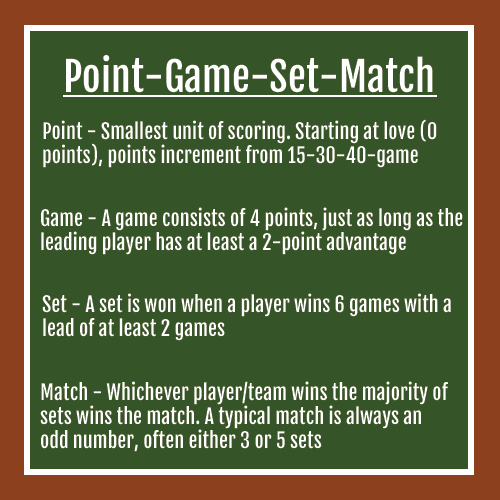Tennis Scoring System
Whether you are just a tennis enthusiast who wants to understand who’s winning in a game of tennis or you’re just starting off playing matches of your own, it’s important to know the official tennis scoring system and the various terms that are a part of it. Without knowing this stuff, you might be left feeling a little confused whenever someone talks about tennis scores around you. So, today we’ll be going over the different components of the tennis scoring system, including how to score tennis matches with an example.
Tennis Scoring System
The tennis scoring system is quite different from the scoring systems used for other conventional sports. Whereas most other sports use just a plain ol’ “point” for scoring, tennis had to go above and beyond just to confuse you by using a ton of jargon. Not only that, but the tennis scoring system does not allow for ties of any kind; there can only be one clear winner and one clear loser for a match. So, let’s touch up on the different terms of the tennis scoring system, shall we?
Terms
Points (or, Score):
A point is the smallest unit of scoring in tennis. In order to win a “game“, a player must win a total of 4 points with a lead of at least 2. But, tennis players don’t use a rationally easy-to-remember system for points (naturally, 0-1-2-3-4). Of course not, tennis players use predefined terms for the amount of points a player has, and the system is as follows:
- 0 Points — Love
- 1 Point — 15
- 2 Points — 30
- 3 Points — 40
- 4 Points — Game (2 point lead required)
Kind of confusing? Don’t worry, you’ll have the tennis scoring rules memorized in no time. Besides knowing these, there are a few more terms you’ll need to know:
- All — Used to describe even scores, except for 40-40. A score of 0-0 would be love-all, 15-15 would be 15-all, and 30-30 would be 30-all.
- Deuce — Used to describe a score of 40-40. If a deuce is reached, a player must win 2 consecutive points in order to win the game. If a player wins one point and then loses the next point, the score returns to deuce.
- Advantage — The player who wins the first point after a deuce is reached is said to have “advantage”.
- Advantage In — If the server is the player who has advantage, the server may announce the score as “advantage in”.
- Advantage Out — If the receiver is the player who has advantage, the server may announce the score as “advantage out”.
If you’re wondering why the tennis scoring system is formatted like this, we really don’t have a clear answer. The best guess that anyone has at the moment is that it originated sometime in medieval France.
One theory states that the tennis scoring system derives from the face of a clock. The goal would be to reach 60, so every point would advance the player by 15 except for the last point. This would allow for the rule of deuce, so that if players reached a deuce, one would have to win 2 points (40 => 50 => 60) in order to reach 60.
Another theory suggests that the tennis scoring system came from the French game “Jeu de Paume“, where the server could move forward 15 feet if a point was scored, another 15 feet if another point was scored, and finally 10 feet closer if the server scored a third time.
As to how the usage of “love” came about, one guess claims that it comes from the French expression for “the egg“, or “l’oeuf“, because an egg resembles the number zero.
Sets
A set is won by the first player/team to win 6 games. Players alternate between serving and returning every game, and most matches either use one of two set formats:
- Advantage Set – The player or team must win at least 6 games with a 2-game advantage over their opponent(s). The set continues until a player/team wins the set by at least 2 games.
- Tie-Break Set – Introduced in 1965 by James Van Alen, the tie-break was created in order to speed up matches. The player or team must win at least 6 games with a 2-game advantage over their opponent(s). If a score of 6-6 is reached, a tie-break game is played to determine the winner. A player must score a set amount of points (typically 7, 8, or 10 points) with at least a 2 point lead in order to win the tie-break game and set.
Matches
A match is typically composed of an odd-number of sets, and the player/team must win the majority of sets in order to win the match. Typical matches are often best out of 3 sets or 5 sets.
How to Score Tennis
 Now that we’ve gone over the tennis scoring system and the various terms that are associated with it, let’s take a look at how to score tennis matches with an example, progressing from the very start to the very end of a singles match.
Now that we’ve gone over the tennis scoring system and the various terms that are associated with it, let’s take a look at how to score tennis matches with an example, progressing from the very start to the very end of a singles match.
First of all, the game begins with a toss, which will determine who serves first in a match. It’s as simple as flipping a coin or spinning the racket, with the player who called it correctly being able to either choose who serves or which end of the court they want to play. The loser of the toss gets to pick the option left.
Let’s say that player 1 wins the toss and chooses to serve first; player 1 will serve the entire first game until a player wins. Player 2 then picks which side of the court they want to play first. Player 1 starts by serving on the right side of the court, and if the serve lands within the opponent’s service box, play continues.
Let’s say that player 1 wins the first point. The score will now be “15-love”, and it is the server’s responsibility to announce the score at the start of each point (unless it’s a tournament where players are pampered).
Player 1 will now shift over to the left side of the court (advantage court) to serve, alternating sides for each new point.
Player 2 wins this point so the score would be “15-all”.
Player 1 wins the next point so it would be “30-15” .
Player 1 wins the next point after and the score would be “40-15”, which can also be known as a double game point since the leading player is ahead by 2 points and just needs 1 more to win the game. A score of “40-30” would be a game point while a score of “40-love” would be a triple game point. If the scores were reversed, the term used would be a break point, double break point, and triple break point.
If player 1 wins the next point, then player 1 wins the game.
If player 2 wins 2 consecutive points while the score is “40-15”, the score would become “40-40”, or “deuce”, which would prompt additional play. Remember, a player wins a game by reaching 4 points with at least a 2 point lead.
Let’s say situation B were to occur and the score is now “deuce”. Player 1 wins a point, so now the score is “advantage in” for the server. Player 2 wins the next point, so the score returns to deuce. Afterwards, player 2 wins another point, so the score is “advantage out” for the server now. Player 2 wins a third point after this and wins the game.
Now, it’s not over yet. We know, it might seem complicated at first but all of this is necessary to know if you want to know how to keep score in tennis. So now it is player 2’s turn to serve for the entirety of the second game. At the start of each game, the server announces the game score, starting with their own score. In this case, the score would be “1-0”. Let’s say player 2 wins this game as well. It is now player 1’s turn to serve again.
For every odd-numbered games, players switch court sides to serve. So, player 1 will switch over to where player 2 had just played, and vice versa. Player 1 announces the score, “0-2”, and the third game begins.
Whichever player wins 6 games with at least a 2 game advantage wins the set. So, the possible scores for winning a set are “6-0”, “6-1”, “6-2”, “6-3”, or “6-4”. If the score reaches “6-5”, the leading player must win 1 more game to take the set. If the score reaches “6-6”, play will continue with either an advantage set or a tie-break game. Remember those tennis scoring system terms yet? If not, we’ll refresh your memory:
- For an advantage set, a player doesn’t win until s/he has a 2 game lead. Example advantage set scores would be “9-7”, “8-6”, “8-10”, etc.
- For a tie-break game, the first player to reach 7 points (best of 12) with at least a 2 point advantage wins the set. There are also different rules for serving in a tie-break game.
After a set is finished, another set begins, with the previous player that received now serving. This continues until a player wins the majority of sets–typically 2 out of 3 sets or 3 out of 5 sets.
After all of this is done, whoever wins the majority of sets wins that match, and this typically allows the player/team to advance in the tournament. And that, ladies and gentlemen, is how to score tennis matches like a professional.

